Published November 22, 2024. This post may contain affiliate links. Please read my disclosure policy.
Learn how to infuse cornish game hens with outstanding flavor and moisture with this Brined Cornish Hens Recipe. It’s a simple but effective method for perfectly cooked chicken that’s golden brown and crispy on the outside and juicy on the inside.
Brined cornish hens are a great alternative to your typical holiday roast turkey. If you’re looking for more straightforward yet sophisticated brined proteins to enjoy during the holiday season, you’ll also love my Brined Smoked Turkey and Home-Cured Smoked Ham recipes.
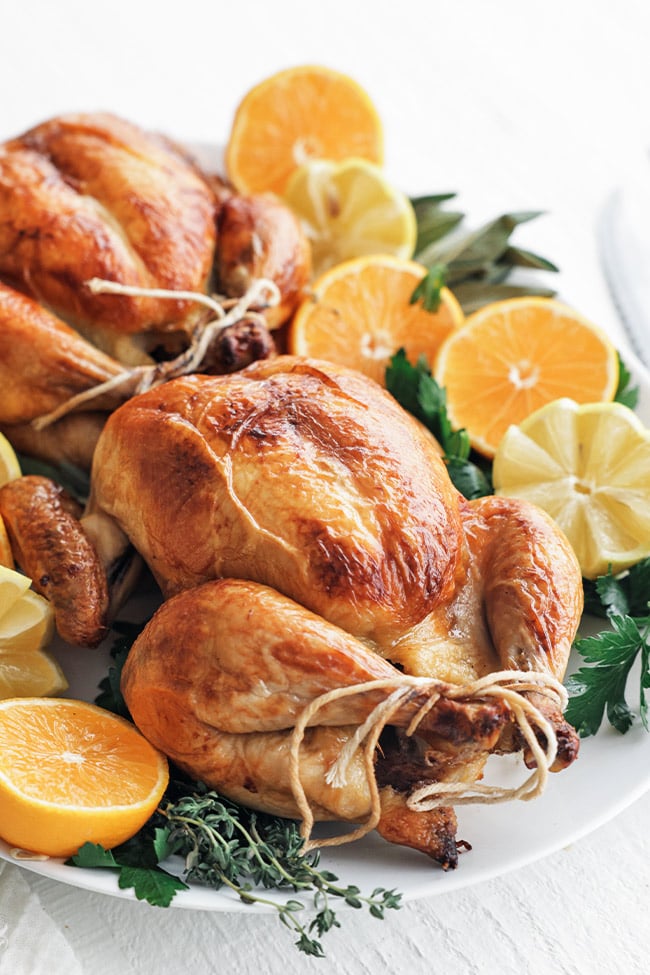
Brined Cornish Hens
Cornish hens, AKA Cornish game hens, are a cross between a Cornish and White Rock chicken. These birds are typically harvested young (when they’re about 4 to 6 weeks old) when they weigh between 1 and 2 ½ pounds. Because they’re smaller than your average roasted chicken or turkey, they make for a perfect personal-sized portion for everyone at the dinner table.
A brine is a saltwater solution infused with herbs, spices, and other aromatics used to enhance the flavor and juiciness of lean poultry. In this recipe, two cornish hens are soaked in a flavorful brine for several hours or even days to intensify their flavor and ensure the meat remains juicy and tender, even after roasting in the oven at a high temperature.
Ingredients and Substitutions

- Water – Always start a brine with cold or room-temperature water to help dissolve the salt and sugar without prematurely cooking the other ingredients.
- Acid — Lemon juice will help tenderize the meat. If you love a noticeable hint of lemon in your chicken, add lemon peel to the brine. Apple cider vinegar or white vinegar will also work as substitutes.
- Aromatics – I used yellow onion and fresh garlic cloves to impart rich, savory notes to the brine. Other aromatics you can use are white onions, shallots, or red onions.
- Seasonings – Whole black peppercorns add a subtle kick, while a good amount of coarse salt penetrates the meat to make it more tender. Kosher salt or sea salt is best for wet brines, but table salt will work as a substitute. Just use half of the amount since the granules are very fine and more concentrated.
- Herbs – I used fresh thyme sprigs and sage leaves since they’re classic poultry herbs. You can also add fresh rosemary, marjoram, or bay leaves. If you only have dried herbs, reduce them by half since they are more potent.
- Sugar – It balances the saltiness, helps tenderize the meat, and enhances the natural flavors. You can use white or brown sugar.
- Cornish hens – You’ll need two frozen or fresh Cornish game hens. If frozen, thaw the birds in the fridge for 1 to 2 days before brining.
- Ice – Just enough to cool down the brining solution after boiling.
How to Brine Cornish Hens
Add the water, lemon juice, fresh herbs, garlic cloves, peppercorns, salt, onion, and sugar to a large pot.
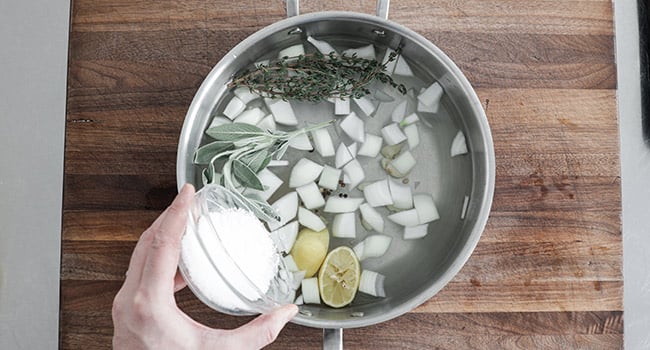
Heat the mixture to a boil on the stove and stir until the salt and sugar completely dissolve.
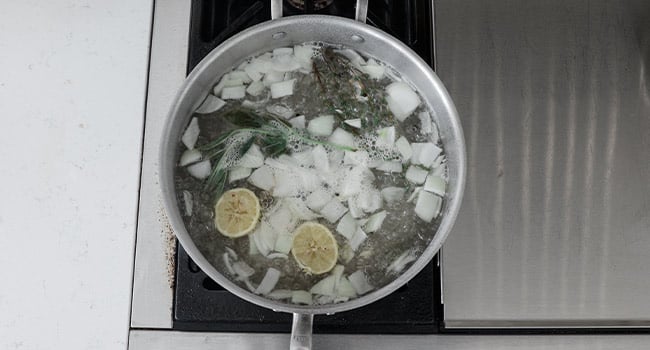
Turn the heat off and immediately stir the ice to cool the brine.
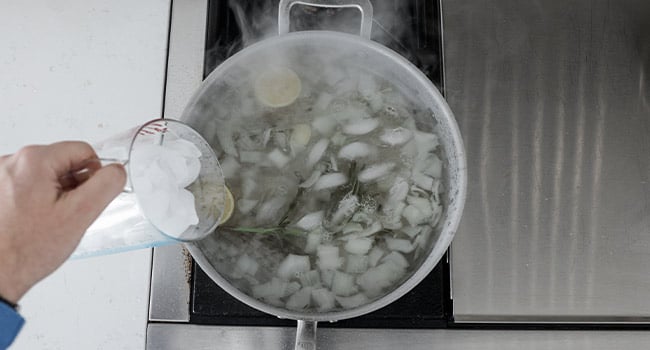
Pour the cooled brine into a large container.
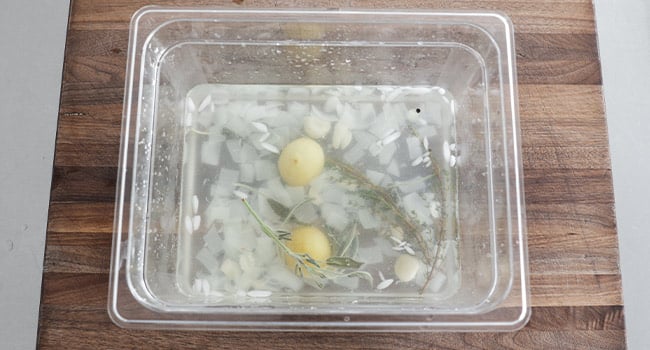
Submerge the cornish hens in the brine. I usually place a couple of plates on top to keep them fully submerged.
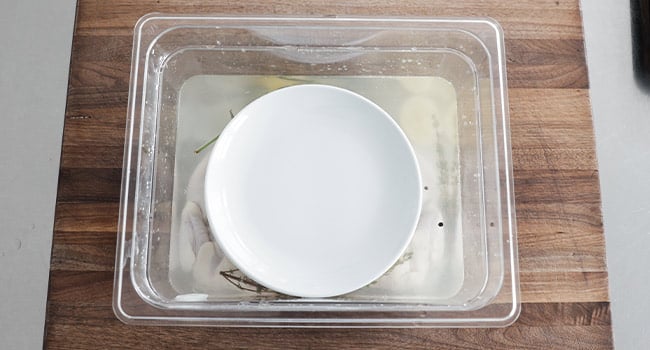
Cover the container and refrigerate the brine for at least 12 hours or up to 48 hours.
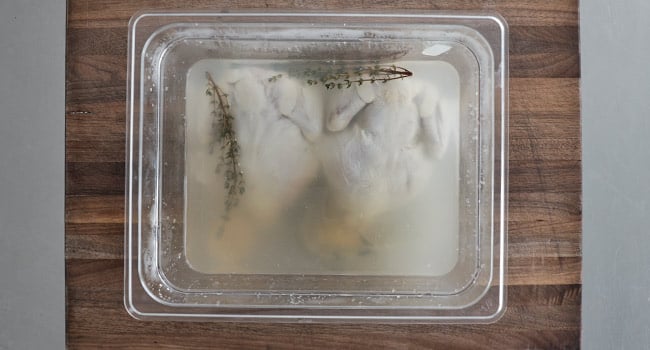
When you’re ready to cook, remove the hens from the brine and rinse them under cold water to remove the brine so that they are not over-salted.
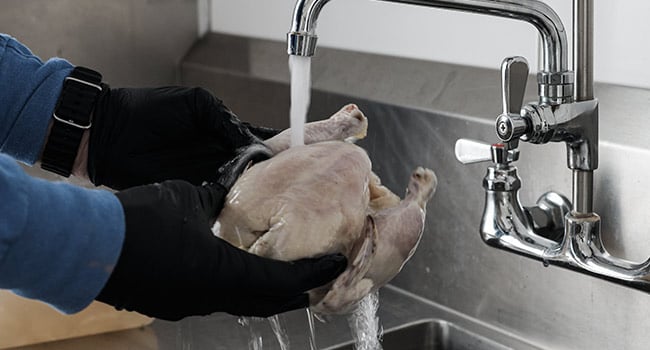
Pat them completely dry with paper towels.
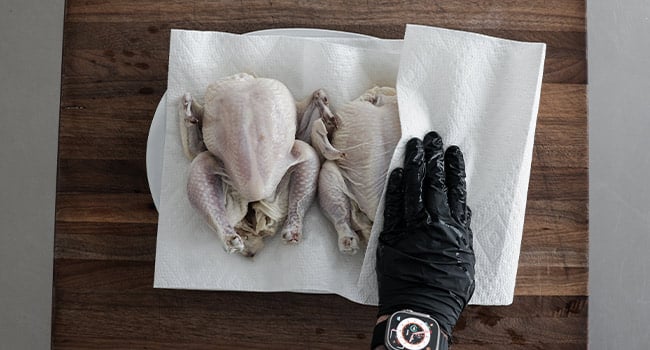
Place the hens on a rack fitted over a sheet tray. Fold the wings behind the body and tie the legs together with butcher’s twine.
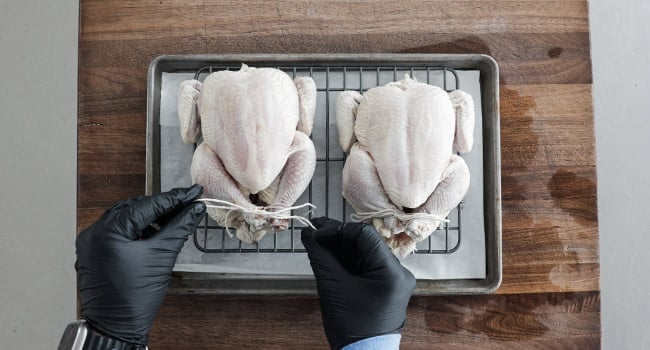
Roast the hens until the thickest part of the breast reaches an internal temperature of 165°F. Set the roasted cornish hens aside to rest for 5 to 10 minutes before serving them with classic sides, like Creamy Mashed Potatoes, Traditional Rice Pilaf, or Homemade Stuffing.
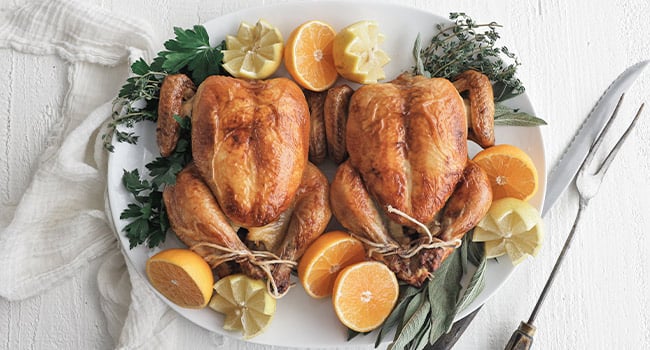
Make-Ahead and Storage
Make-Ahead: The hens can be submerged in the brine for up to 48 hours before roasting. You can also roast the hens 1 hour ahead of serving them. Cover them with foil and keep them warm in a 200ºF oven until it’s time to eat.
How to Store: Once cooked and cooled, refrigerate the hens in an airtight container for up to 3 days. Or, wrap them tightly in plastic wrap and foil, then freeze them for up to 2 months. Thaw the hens overnight in the refrigerator before reheating.
How to Reheat: Place the Cornish hens on a wire rack fitted in a baking pan with 1/2 cup of water on the bottom. Cover them with foil and reheat in a 350°F oven for 15 to 20 minutes or until hot.

Chef Notes + Tips
- Any large soup pot and 3 to 5-gallon container should be big enough to hold the brine and both hens.
- Do not brine the hens for longer than 48 hours. Otherwise, the proteins in the meat will begin to break down, become mushy, and taste overly salty.
- If you’re short on time, a 4-hour brine will still impart flavor and moisture into the meat. However, a 12 to 48-hour brine is always best.
- For the crispiest skin, pat the outside and inside of the hens very dry with paper towels. Moisture on the skin can prevent it from becoming crispy during roasting.
- If your brined Cornish hens are browning too quickly in the oven, loosely tent them with aluminum foil.
- Trussing (tying the legs together) helps the hens cook evenly and prevents the wings from burning. My guide on trussing a chicken with butcher’s twine will help you with this step. Remember to remove the twine before serving.
- I highly recommend investing in a quality meat thermometer to ensure your hens are cooked to the perfect internal temperature of 165ºF.
More Chicken Recipes

Brined Cornish Hens
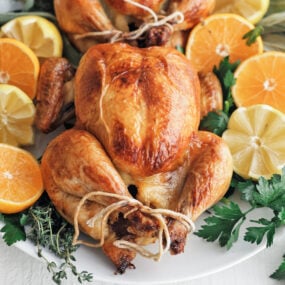
Ingredients
- 8 cups water
- juice of 1 lemon
- 6-8 sprigs of fresh thyme
- 6-8 sprigs of fresh sage
- 4 garlic cloves
- 15 peppercorns
- ½ cup coarse salt
- 1 peeled large diced yellow onion
- 2 tablespoons sugar
- 2 Cornish hens
- 8 cups of ice
Instructions
- Add water, lemon, thyme, sage, garlic, peppercorns, salt, onion, and sugar to a large pot.
- Boil the mixture and ensure all the salt and sugar are completely dissolved.
- Cool it immediately with the ice.
- Transfer it to a large container.
- Place in the hens and keep them submerged. I like to add a few plates on top of them to keep them under the brine.
- Place them in the fridge for 12 to 48 hours.
- When you’re ready to cook them, preheat the oven to 400° with the convection on or 425 without it.
- Take the hens out of the brine and rinse them well under cold water.
- Next, pat them dry very well with paper towels all around and inside.
- Transfer them to a rack over a sheet tray. Fold the wings behind the body and tie the legs together with butcher’s twine.
- Bake at 400° convection on a middle rack for 50 to 55 minutes or until the deepest part of the breast reaches 165° internally.
- Remove and rest the hens for 5 to 10 minutes before serving.

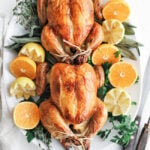
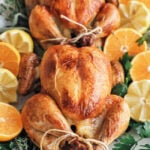
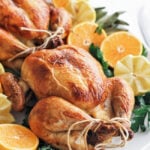
Brined Cornish Hens Recipe